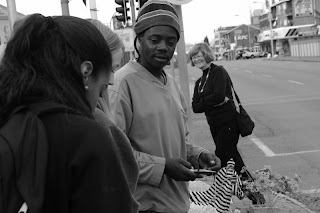This past weekend we were fortunate enough to visit Kasane, a small touristy town in Northern Botswana. While there, we spent time on a game reserve, experiencing the uniqueness and wonder of Africa through its wildlife. We departed on the eleven o'clock bus and traveled six hours. When we arrived at the bus rank, we set out on foot to find a place to eat.
Sadly enough, the options were pretty limited, and we ended up dining at the nicest KFC I have ever laid eyes on. So it was not too bad at all, especially when I was able to order mashed potatoes. Oh, how I have missed potatoes... even the instant mashed potatoes of KFC hit the spot. We then caught a taxi to the lodge where we would be residing, the Toro Safari Lodge. We were informed that it was a two-star accommodation, but it was a very nice resort to our pleasant surprise! The beds were beyond welcoming in their comfort. That night we reflected on our trip as a whole around a fire, drinking our nightly tea before retiring to bed in preparation for our early start.
Five came very early the next morning. Not only did it come early, but it came with unbelievable frigidness, which was multiplied greatly while sitting in the back of a seated safari truck driving down the road for about twenty minutes. The cold we experienced was just short of creating that painful tingling sensation in one's extremities.
However, once we began seeing animals, the cold was more than worth enduring. In the beginning, we were only seeing guinea fowl: interesting but not breath-taking. Then we saw impala, and soon we were seeing so many impala that they became common. When we reached the edge of the Chobe River we saw hippos standing in the water. Later in the tour, giraffes were present and quite plentiful; they are such tall creatures. Baboons presented themselves soon before our break to stretch our legs. For some reason, I was not thinking that we would see monkeys, so that was a pleasant surprise for me.
Most amazingly, we were able to witness a leopard chilling in the shade. We sat there for quite some time just staring intently at the cat. Then we noticed that on the other side of the road was its meal, a headless impala suspended high up in the branches of a tree. This was amazing to see! Kudu came next, which look like a combination of several different animals including camels, donkeys, and impala. They are quite captivating to look at with all their characteristics. Lastly, there was an elephant soon before we exited the reserve; they look so much larger in person!
Starting at 3 in the afternoon, we set off by boat to see more creatures of Africa. Again, we saw hippos, but this time they were basking in the sun of the afternoon. Elephants proved to be very plentiful near the water at this time. We were even able to see a herd approach the water, and within that herd was a baby that could not have been more than a few weeks old. It was so precious! The care and devotion elephants show to one another is truly amazing.
Water buffalo were dispersed throughout the boat ride as well. At one point we came upon crocodiles sleeping on a patch of land. We were able to be intimidatingly close in proximity to the reptiles, which were so surprisingly large! Seeing all of God's creation living together peacefully is overwhelmingly beautiful. It was a very exciting experience to be able to see the animals going about their business in their natural habitats, not just fenced in at a zoo.
However, the most exhilarating part of the trip was returning to Francistown and going to the youth center. All of the youth seemed so genuinely interested in our experience and happy to see us return. I think I can speak for Leah and Vanessa when I say that we really became attached to all the people at the center, and it is definitely difficult to be parting ways so soon; we are so grateful for all the moments we have been able to experience.
Lacey































